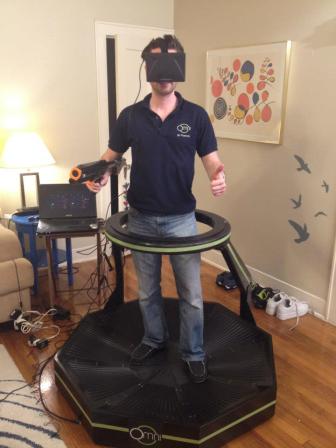 Editor's note: Ross Rubin is principal analyst at Reticle Research and blogs at Techspressive. Follow him on Twitter @rossrubin.
Editor's note: Ross Rubin is principal analyst at Reticle Research and blogs at Techspressive. Follow him on Twitter @rossrubin.
Now that there are enough wearable sensors on the market to track one activity per day each week, we've seen some sensor-based products turn their attention to chilling out already. There's the Melon headband that helps determine how you best focus, Phyode's W/Me wristband that aims to monitor a broad aspect of your physical state, and the PIP that uses a combination of software and biofeedback to help you learn how to de-stress.
At least one project owner is gearing up to add another technological tool to the active arsenal. Part videogame accessory and part exercise equipment, the Virtuix Omni was inspired by the success of Kinect a few years ago, itself a response to the "Wiimote controller" that defined Nintendo's last gaming console. While both products get you off the couch, they don't necessarily give you any place to go once you're there.
Just like virtual reality goggles expand the viewing area beyond what is possible with conventional displays, the Omni expands where one can walk in conventional rooms where games are played. It is an omnidirectional treadmill. Indeed, the success of the crowdfunded Oculus Rift virtual reality headset that netted over $2.4 million on Kickstarter convinced inventor Jan Goetgeluk that the funding site would be a good route to market for a technology that had seen a lot of IP patents filed but few consumer products. Backers, many of whom were undoubtedly idle on their chairs as they pledged, were driven by promise (and perhaps a bit of guilt) to meet the initial funding goal in three-and-a-half hours. Two weeks and still with a month to go, the campaign has raised $860,000.
 As is the case for Oculus, gaming is only the first market for Omni, which can be used in simulations, training and other applications. Even better, unlike the Oculus Rift, which has elements of input and output and requires that games be modified for compatibility, the input-only Omni is compatible with PC games out of the box and is much easier to demonstrate. Nevertheless, while both products are slated to ship in consumer versions in early 2014, VR is still a niche market.
As is the case for Oculus, gaming is only the first market for Omni, which can be used in simulations, training and other applications. Even better, unlike the Oculus Rift, which has elements of input and output and requires that games be modified for compatibility, the input-only Omni is compatible with PC games out of the box and is much easier to demonstrate. Nevertheless, while both products are slated to ship in consumer versions in early 2014, VR is still a niche market.
Part of the reason for the reality check relates to the Omni's size (about that of a standard treadmill although it's designed to be disassembled quickly) and price, which will be around $500 or $600. That will make it more expensive than either of the next-generation consoles from Sony and Microsoft launching in the fall, with the latter including a souped-up version of Kinect. In addition, while using a Kinect can also require a wide berth, the Omni has its share of encumbrances during use, including a belt and shoes that require special soles. (The company is partnering with an existing shoe manufacturer for the uppers.)
And competition is already using crowdfunding to compete with the Omni. A simpler, smaller and cheaper omnidirectional surface called the WizDish developed in London dispenses with the Omni's frame and integrated sensor. The WizDish is expected to ship before the end of the year for less than $300, but a demonstration video on its Kickstarter page has a first-timer stepping onto it as one a wet bathtub surface with a remote voice urging the user to be "really careful." In these early days of omnidirectional treadmills, the feature sets — as well as some of the users — will struggle for balance.
No hay comentarios:
Publicar un comentario